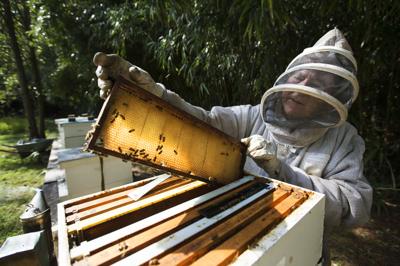So, what are the new beekeepers learning about their bees? They are learning about festooning, which is when the bees are making wax and filling the hive with the essential wax needed for the hive. The bees gather over the area and vibrate their wing muscles, which raises the temperature of the wax by approximately two degrees, thus allowing the wax needs of the hive. Bees of a certain age develop wax glands on their abdomens during this process.
During the festooning process, one can slide their finger behind that cloud of bees and gently move it outward. I believe this is a valuable learning experience for a new beekeeper. It is that time of the year for swarms to appear.

Swarms are a nature way for bees to divide. Swarms will emerge from a parent hive with the old queen and they will land a short distance from the hive as the queen hasn’t flown in over a year. They may remain in this area for any length of time.
They pose no danger, as they have gorged on honey and their plan is to start a new hive. If you contact a beekeeper, they can capture that swarm and it stands a high percentage of survival, but if left on their own, there is a small chance for survival. What happened to all of the bees that traveled to California to pollinate all of the almonds? They traveled to Washington/Oregon to pollinate cherries and apples.
After that pollination is complete, they will return to their home base, where they will do local pollination or make honey. For those keeping up with the local flora, the little while blooms alongside the road are dewberries. They normally will be less than a foot tall, then coming along behind them will be the blackberries with a very similar white bloom, but the canes will be several feet tall.
Those blackberries will not be ready for picking before the Fourth of July. Most berries are wind pollinated, but produce a much larger, sweeter bloom if pollinated by bees. Also, that is why you will see honeybee hives on strawberry fields.
Blackberry plants are one of the most nutritious plants for honeybees. What is happening at Allendale Correctional? The spring honey flow is underway with the wisteria and blackberry blooms. There will be some honey that will come in from tulip poplar near the institution.
Their hives have been treated for mites and are thriving. With careful monitoring, we hope that this will continue through the summer. After the honey flow, there will be a basic course and a journeyman course that I will be teaching them.
Hopefully there will be a great deal of cotton planted next to the institution, which would provide them with a mid-summer honey flow..
Technology

BOMMER'S BEES: New beekeepers are learning about their bees

So, what are the new beekeepers learning about their bees? They are learning about festooning, which is when the bees are making wax and filling the hive with the essential wax needed for the hive. The bees gather over the...















